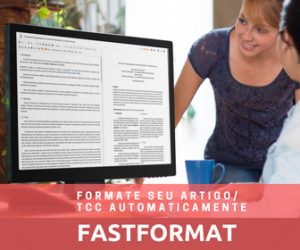One of the most laborious parts of all academic work is researching and writing the Theoretical Background. Be it a Final Year / Senior Project, Undergraduate / Bachelors Dissertation, journal articles, or even partial and final reports, it will always be necessary to review the literature already produced on the subject.
No research comes out of nowhere. Something must have already been done to arouse the interest of those who are going to develop a scientific work. There are even works, such as in some dissertations and theses, where a chapter is dedicated solely to Theoretical Foundation, or as it is also known, Related Work, Theoretical Reference, Bibliographic Review or even Literature Review.
To find out if a chapter must be dedicated to the Theoretical Foundation in your work, you must know the rules of your educational institution or, in the case of an article or book chapter, for example, the rules of the editorial board.
But don’t be scared because we are here to help you get rid of this task in the most practical way possible, without losing quality.
What is the Theoretical Foundation for?
It serves to give theoretical foundation to scientific works, from the research project to the final writing of your dissertation or thesis. Literature should be directed to what is your research problem, history, methodologies, results. Shows the opinions and facts you used to construct your point of view.
The theoretical framework also helps to interpret the data and discuss the results, by comparison with results found in related works, as well as in determining the methodology to be adopted and in qualifying the research.
Example:
…different from that described by So-and-so (2009), when he found a positive correlation between the X factor and the Y variable, in this research there was no correlation between the same elements.
How to start developing your Theoretical Foundation?
It is important that before starting your bibliographic research you have already outlined, in addition to the central theme, your objectives and methodologies. The opinion of your advisor is always essential. Talk to him about the readings you should take and which path to take in your arguments.
If you don’t know it yet, look for information from authors who stand out in the area of your research. A good source is the bibliographic references of articles. Consulting several articles, you can find the most active researchers in your subject and, through these references, you find and consult the different approaches to each one.
When highlighting the main points of your research and searching for publications related to each point, don’t be limited to the opinions of one or two authors. Diversify your references as much as you can about your topic with authors who share different points of view on the same subject.
Determining the time frame for searching is important to delimiting how far to search. For example, up to ten years, up to fifteen years, etc. If you know about a very important source, but it is out of time, it should be mentioned.
Contextualizing your research is also extremely important. Therefore, find out about recent or ongoing works that give importance to your work, characterizing it as useful for solving current problems or even for a better understanding of the world.
Ways to search for material for Theoretical Foundation
There are several ways to do a bibliography search. Currently with the ease of the World Wide Web (WWW), we can get in touch with publications in all areas of knowledge, in different languages without leaving home.
However, the library must not be forgotten. Not only because of the collection that characterizes them, but also because we find people there capable of, for example, showing us where to look for historical or very recent material on their subject of study.
Search engines generally use the keyword search system. You need to identify the central theme of your subject. If the topic is very broad, for example “Environmental Preservation”, look in the general objective for the object to be analyzed. In this case, it could be: “investigate the impact of bioplastic packaging on environmental preservation”.
So, you could use as keywords for your initial search, in addition to preservation and environmental as well: environmental impact; types of packaging; manufacture of bioplastics; use of bioplastic for packaging, etc.
For online consultations we have the Google Scholar database that brings together publications from all scientific fields. Some sources require a subscription, but your university may have an agreement with these magazines. Inform yourself.
Conducting Bibliographic Research
To guide you through the research, refer to your specific objectives and around each one compile pertinent information. Each of them can be assigned a subtitle and it can be divided into sections.
First, you search for authors who present the concepts. Then, you look for other authors who based on the initial concepts, carried out practical work and show their results.
Example:
According to Smith (2010) the methodology of public education should be the same adopted in the private network. However, Zimmerman (2013) notes that a social difference is negatively reflected in the adaptation of practices applied in private schools to public education policies.
By selecting well-known authors cited in other works, you will be closer to having reliable material at hand to present in your text. If you cannot determine the veracity of any work, it is better to suppress the passage.
Should you put everything you have found in the Theoretical Foundation?
No. You should carefully read publications and check their sources. In addition to reading each source of your reference, you should highlight the excerpt that you will use in a citation or in the work that you will be based on to write yours.
In fact, in addition to selecting, you’ll have to interpret and mark the parts of interest. In practice, you will not be able to absorb everything you read, nor will you be able to relate the quote literally. But don’t panic! There are techniques to help you at this time.
One of the techniques used in assembling a Theoretical Foundation is filing a worksheet. But, how is it done? Basically, you will put bibliographic data in a form, such as author, title, year of publication and the number of the page from which you are going to make the citation.
Each form corresponds to a bibliographic source and must contain a summary of what it is about and/or the literal transcription of the author, in the case of direct citation (quote). Learn more about this in our blog article: “Bibliography worksheet: how to do it, types and examples”.
This technique makes it much easier when composing your writing. Much more so if you already make notes in electronic format and follow the publication standards of your institution (or journal), since you will be able to include it in your text with ease.
How to compose the text of your Theoretical Foundation?
To facilitate the composition of your Theoretical Foundation, make a plan for structuring in titles and subtitles. The central theme of your subject should start your review. Research and select what other authors say about your research subject.
The Theoretical Foundation is an organized text, with logically connected content. It must be written in a way that is conducive to understanding. It’s not just gathering references and placing them at random.
For example, don’t highlight a “loose sentence” in the middle of an article to fill in gaps in your text. Ensure that such a phrase is in a context that directly refers to what you are going to denote.
Your authorial text should contribute more of the writing than the citations, approximately 80% should be your own words.
Time to write your Theoretical Foundation text
The objective of the theoretical foundation of a work is not to create new knowledge, but rather to report the work that other authors have developed on the topic of their research. However, the writing is yours. You must make a narrative based entirely on the opinions of these authors.
At this point, it is necessary to carefully observe how to quote other authors. Remember that it is not your opinion that will be quoted. It will be necessary to make the proper reference not to incur in plagiarism. It is a descriptive text, in third person, where no personal opinions are placed.
When writing or using any literary reference, one must faithfully follow the publication rules of the institution/journal (such as ABNT, APA, Chicago, MLA, Harvard, etc.) for direct or indirect citation and to make the respective bibliographic reference.
Use the in-text citation as little as necessary, that is, the expression “as cited in” should only be used when it is really indispensable. If possible, use the original source.
Try not to make too many direct quotes. If you do, don’t make them too long, with a maximum of 3 lines.
Now, with our tips and FastFormat automatically formatting your citations and references, it will be much easier to write the theoretical foundation of your work.
Good work!
Experimente grátis o FastFormat
Além da formatação automática, o FastFormat conta com vários recursos para facilitar a construção de seus trabalhos acadêmicos. Acesse agora!




Add comment